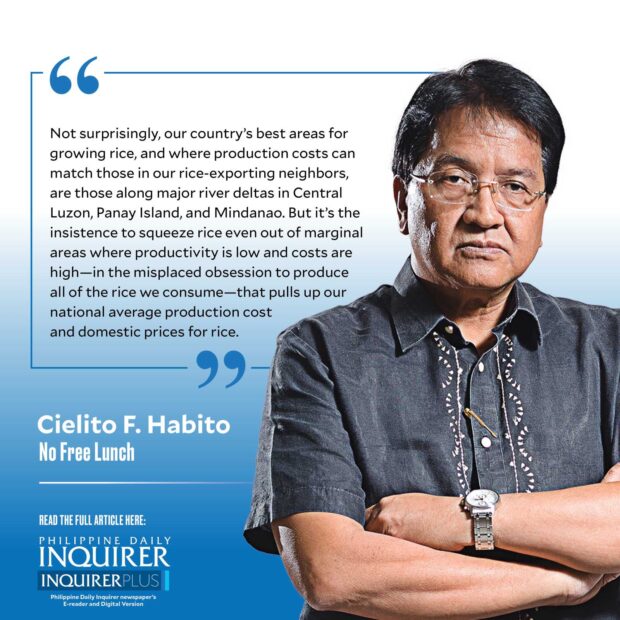Why Does the Philippines Import Rice?” was the title of a book published in 2006 by the International Rice Research Institute and Philippine Rice Research Institute, with a foreword jointly signed by then IRRI director general Robert S. Ziegler and PhilRice executive director Leocadio S. Sebastian (now undersecretary for Rice Industry Development at the Department of Agriculture). The book compiles interesting facts and analyses by rice scholars from both institutions, which remain very relevant to the raging debate on rice trade that persists today.
Editors David Dawe, Piedad Moya, and Sheryll Casiwan address the question at the outset: “Many reasons are typically advanced for the failure to achieve rice self-sufficiency—faulty government policy, corruption, conversion of rice land to other uses, backward rice farmers, deteriorating irrigation systems, and lack of farm credit, among others. But all countries, including several rice exporters, complain about these problems. Although some of these problems are important, they do not explain why the Philippines imports rice.” But “the real answer is not so bad: in a word, it is geography. The Philippines imports rice because it is a nation of islands without any major river deltas like those in Thailand and Vietnam.”
The book clarifies some common misconceptions about rice production in the Philippines: “Losses of land to urbanization are easy to see because they occur in populated areas, but the effects are small and are more than offset by cropland expansion elsewhere. In fact, rice area harvested in the Philippines has been at record highs during the past five years, reaching 4 million hectares for the first time in history.” While this was 17 years ago, I’ve cited data in this column showing that total cultivated area in the country continued to grow over time up to now, contrary to alarmist fears of dwindling farm areas due to land conversion (see “Myths and misconceptions,” 6/21/22, and “Easing land conversion,” 5/9/23).
It’s also commonly believed that Filipino farmers are backward and produce rice inefficiently. But the book cites how a detailed survey of farmers in the various rice bowls of Asia found that “Filipino farmers were among the leaders in reducing insecticide use, and have progressed farther in mechanizing land preparation and postharvest operations than their counterparts in any other developing Asian country except Thailand.” But one factor unique to our country, being at the eastern edge of the Asian continent, is how we bear the brunt of numerous typhoons that make rice production more difficult and risky. In contrast, Thailand and its Mekong River Delta neighbors are much less affected.
The book groups Asian rice-eating countries into two “clubs”: rice importers and rice exporters. “The fact that countries remain in one club or the other for long periods of time suggests that some deep force is at work. That deep force is endowments of land and water … Exporters occupy river deltas with lots of land in general, and lots of land suitable for rice in particular. These countries are all located in mainland Southeast Asia: Thailand, Vietnam, Cambodia, and Myanmar. For example, Thailand has about four times the quantity of arable land per person as the Philippines. Consistent importers have less arable land per person and more varied landscapes favoring such alternatives as corn, oil palm, or coconut. These countries are all islands (Indonesia, the Philippines, Japan, Sri Lanka) or, in the case of Malaysia, part island and part narrow peninsula.”
Not surprisingly, our country’s best areas for growing rice, and where production costs can match those in our rice-exporting neighbors, are those along major river deltas in Central Luzon, Panay Island, and Mindanao. But it’s the insistence to squeeze rice even out of marginal areas where productivity is low and costs are high—in the misplaced obsession to produce all of the rice we consume—that pulls up our national average production cost and domestic prices for rice. Coupled with the policy of insulating our domestic market from competition from imported rice, it has led to another little-known fact that the book documents: Filipino farmers actually receive much higher prices—up to nearly twice—for their palay than their counterparts in our neighbors do.
But studies, including by top poverty expert and current National Economic and Development Authority chief Dr. Arsenio Balisacan, consistently show that even our small rice farmers and their families are net rice buyers—that is, they collectively consume more rice than they produce. This tells us that our tight trade restrictions that have led to our very high rice prices hurt them more than it helps. This must change.
—————-
cielito.habito@gmail.com
